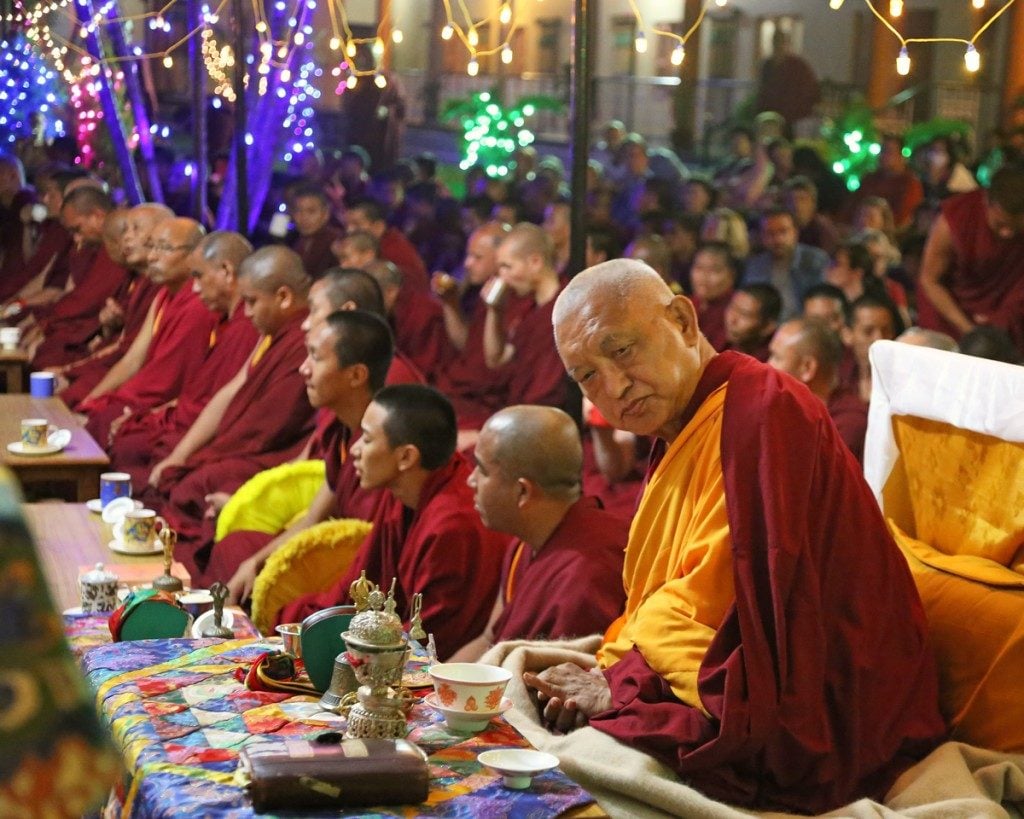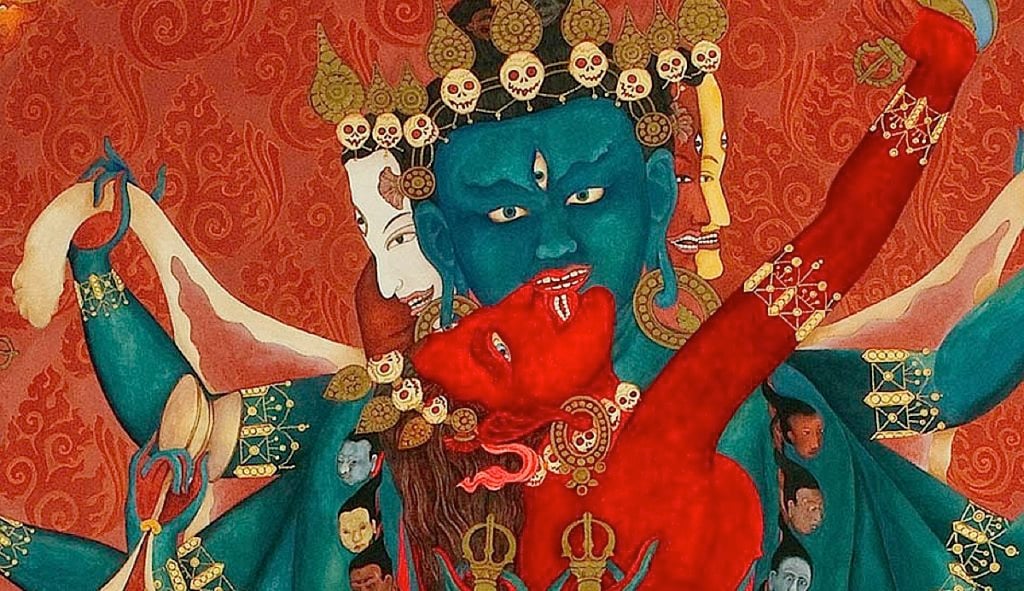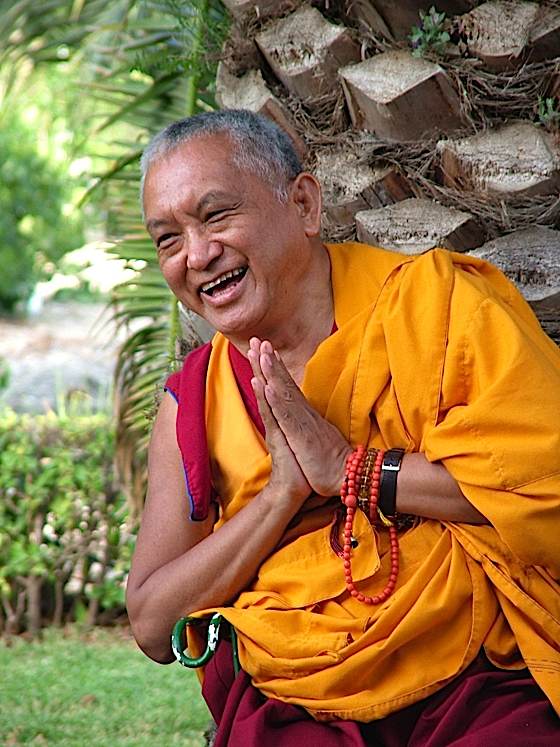What is Tsog, and why is it so precious and important? From the Heruka Root Tantra: Quickly attempt to make offerings Every waxing and waning of each month do tsog. NOTE: Tsog Dates for 2024 below in table. Tsog...
What is Tsog, and why is it so precious and important?
From the Heruka Root Tantra:
Quickly attempt to make offerings
Every waxing and waning of each month do tsog.
NOTE: Tsog Dates for 2024 below in table.
 Lama Zopa Rinpoche at a puja.
Lama Zopa Rinpoche at a puja.
Tsog Purpose
The Heruka Root Tantra explains the purpose of Tsog offering, which is to remove obstacles and hardships:
The waxing and waning of each month
If good tsog is offered
Then one has no hardships, no difficulties
And one goes to the pure land of Tharpo Kachoe
 Tsog is carefully described in the Heruka Root Tantra. Image: Heruka Chakrasamvara with Vajrayogini (Heruka and Dakini). Photo of detail of author’s gorgeous thangka created by magnificent artist Laura Santi>>
Tsog is carefully described in the Heruka Root Tantra. Image: Heruka Chakrasamvara with Vajrayogini (Heruka and Dakini). Photo of detail of author’s gorgeous thangka created by magnificent artist Laura Santi>>
Tsog Offering — What it means
H.E. Lama Zopa Rinpoche explains the higher meaning of Tsog offerings:
“The very highest meaning of tsog is to join method and wisdom. The real meaning of experiencing tsog is the transcendental wisdom, non dual great bliss – the wisdom of emptiness, the non-duality of that, and uniting these two. That is the very essence of tsog. It is the offering of that experience, oneself experiencing it, the male and female heroes and heroines, of which the essence is the guru deity, and oneself also experiencing that, as the guru deity. The real meaning of tsog is integrating method and wisdom, the transcendental wisdom, non-dual bliss and voidness (this is the secret meaning).” [1]
 The great Kyabje Lama Zopa Rinpoche.
The great Kyabje Lama Zopa Rinpoche.
Tsog is nearly always at night time. From the Heruka Root Tantra it is explained — night is symbolically when Dakas and Dakinis are more active:
Offering extensive food and drink
Always do at night time – why?
Because it is admired to do at nighttime
Always wander at nighttime and always gather at nighttime.
As always, with Buddhist offerings, the offerings are not “needed” by self-aware deities or Buddhas. The Enlightened have no need of sensory offerings. In general, offerings are an opportunity for us to earn merit to help overcome our negative karmas and attachments. The act of offering, or generosity, is also the “cure” for the grasping, attached mind. And, then there’s Tsog, which is precious especially to the Enlightened Dakinis and Dakas. [For a story on Dakinis and a previous story on Tsog, see>>]
In some practices, the Lunar 10th is often called the “Feast of Heroes” (Feast of Dakas) — and is often a celebration of Guru Rinpoche (Padmasambhava) — and the 25th is the “Feast of Heroines” (Feast of Dakinis.) In others, there is no distinction, so both days are called the “Feast of Dakas and Dakinis” or “Feast of Yogis and Yoginis” (Feast of Heroes and Heroines.)
Pandit Ratna Raksherita explained:
Those doing the activities of the heroes, it is called the feast of the heroes,
Similarly, those doing the activities of yoginis, it is called the feast of the heroines,
Those whose minds are enriched with control of the circle
Of the integrated method and wisdom,
That is called the circle of unification.
Tsog is special
Everything about Tsog is special. We might have tangible, sensory offerings in front of us, but they are “converted” in our minds and by our karmic actions, mantras, visualizations and practices into sacred, special, blissful NECTAR.
H.E. Lama Zopa Rinpoche explains the higher meaning and purpose of Tsog:
The meaning of nectar is not just some special taste, like honey. In Tibetan, the word is du-tsi.Du is mara, tsi is medicine. So here, du is ordinary appearance and ordinary concepts, delusions, negative imprints and defilements. Tsi means medicine —the ultimate medicine is the transcendental wisdom of non-dual bliss and voidness, which is like an atom bomb to cut through those delusions, which are the maras.
One has to think of the meaning of nectar, du-tsi, the transcendental wisdom of non-dual bliss and voidness. By taking that nectar, you generate that experience within you. If you don’t have the actual experience of that, then you visualize it. That blesses the mind, body, and the chakras, the winds and drops. It becomes a preparation to achieve the path, the Highest Tantra accomplishing path of the illusory body and clear light, and it enables you to achieve the resultant Dharmakaya and Rupakaya. Then, one is able to offer perfect works for sentient beings, without the slightest mistake, until everyone, every single sentient being, is brought to enlightenment.
Actual method
For the actual method, this must be guided/taught by a qualified teacher. Normally, you attend as a group, to the Gompa, temple or monastery. If you cannot, or if you are remote, you can do this on your own. There is a ceremony for those empowered to perform Tsog.
It is IMPORTANT to never place the offerings on the ground, even at the end when offering to the protectors. Normally, Tsog is offered to the Dakas and Dakinis, the Buddhas and Bodhisattvas, the Gurus and the Enlightened Protectors. Then, the offering is re-blessed as nectar for the protectors sworn to protect the Dharma and offered outside. Often, a paper plate is used, to prevent the offering from being “tossed” on the ground — which is considered inauspicious, or even a downfall.
Dakini Day and Tsog 2024
January 6 February 5 March 5 April 4 May 3 July 1 and July 30 August 28 September 27 October 26 November 25 December 25Guru Rinpoche Day and Daka Tsog
January 20 February 19 March 19 April 18 May 18 June 16 Annual Birthday of Guru Rinpoche: Considered a Buddha Day July 16 August 14 September 13 October 12 November 11 December 10
NOTES
[1] Source Lama Yeshe Wisdom Archive: “Tsog Offering Practice“












